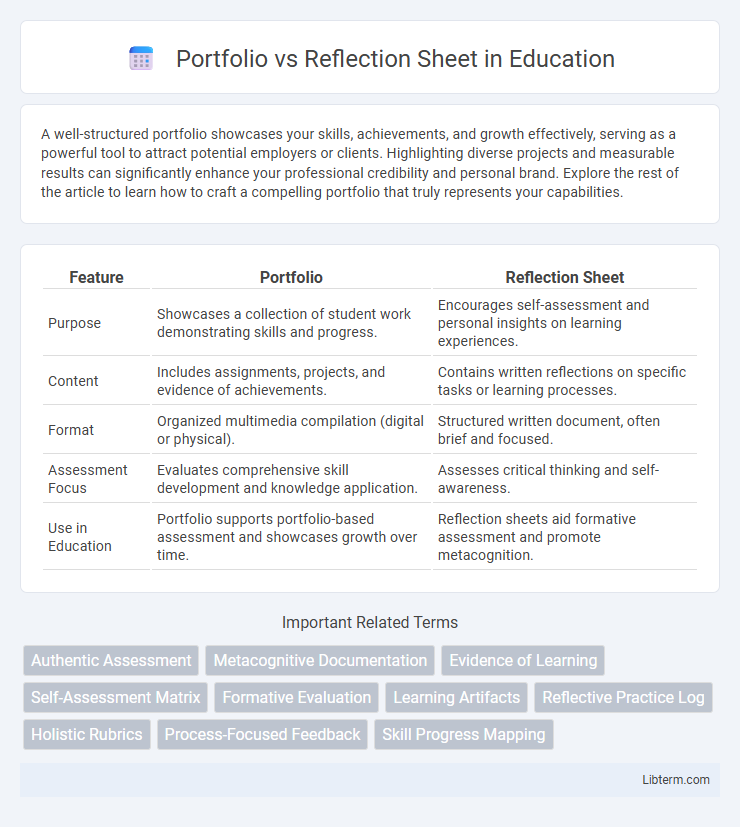A well-structured portfolio showcases your skills, achievements, and growth effectively, serving as a powerful tool to attract potential employers or clients. Highlighting diverse projects and measurable results can significantly enhance your professional credibility and personal brand. Explore the rest of the article to learn how to craft a compelling portfolio that truly represents your capabilities.
Table of Comparison
| Feature | Portfolio | Reflection Sheet |
|---|---|---|
| Purpose | Showcases a collection of student work demonstrating skills and progress. | Encourages self-assessment and personal insights on learning experiences. |
| Content | Includes assignments, projects, and evidence of achievements. | Contains written reflections on specific tasks or learning processes. |
| Format | Organized multimedia compilation (digital or physical). | Structured written document, often brief and focused. |
| Assessment Focus | Evaluates comprehensive skill development and knowledge application. | Assesses critical thinking and self-awareness. |
| Use in Education | Portfolio supports portfolio-based assessment and showcases growth over time. | Reflection sheets aid formative assessment and promote metacognition. |
Introduction to Portfolios and Reflection Sheets
Portfolios compile diverse work samples and evidence showcasing skills, achievements, and progress over time, providing a comprehensive overview of learning and development. Reflection sheets accompany portfolios by prompting individuals to evaluate their experiences, insights, and areas for improvement, fostering critical thinking and self-assessment. Together, portfolios and reflection sheets facilitate holistic evaluation in educational and professional settings, enhancing personal growth and skill mastery.
Defining a Portfolio: Purpose and Features
A portfolio serves as a curated collection of work that showcases an individual's skills, achievements, and learning progress over time. It typically includes diverse artifacts such as documents, projects, and multimedia evidence that demonstrate competencies and growth in specific areas. The main purpose of a portfolio is to provide tangible proof of development, enabling assessment, self-evaluation, and professional presentation.
What is a Reflection Sheet? Key Elements
A reflection sheet is a structured document used for self-assessment and critical thinking about a particular experience, project, or learning process. Key elements include a detailed description of the activity, personal insights or feelings, evaluation of what was learned, challenges faced, and plans for future improvement. This tool promotes deeper understanding by encouraging individuals to analyze their performance and growth systematically.
Portfolio vs Reflection Sheet: Core Differences
A portfolio is a curated collection of work demonstrating skills, achievements, and progress over time, while a reflection sheet focuses on detailed personal insights and learning experiences related to specific tasks or projects. Portfolios emphasize tangible evidence of competency with visual or documented outputs, whereas reflection sheets prioritize critical thinking and self-assessment. Together, these tools complement each other by showcasing both objective performance and subjective growth.
Advantages of Using Portfolios
Portfolios provide a comprehensive showcase of a learner's skills and progress over time, enabling detailed evidence of achievements beyond single assessments. They encourage continuous self-assessment and goal setting, fostering deeper engagement and personal growth. By integrating diverse work samples, portfolios offer a rich, multifaceted view of competencies that reflection sheets alone cannot capture.
Benefits of Reflection Sheets in Learning
Reflection sheets enhance learning by encouraging students to critically analyze their experiences and understand their strengths and areas for improvement. They promote active self-assessment, leading to deeper cognitive engagement and better retention of knowledge. Incorporating reflection sheets fosters metacognitive skills, which are essential for lifelong learning and academic success.
When to Use a Portfolio
A portfolio is best used when showcasing a comprehensive collection of work that demonstrates skills, progress, and achievements over time, especially in fields like art, design, or education. It serves as tangible evidence for academic assessments, job applications, or professional presentations, highlighting the depth and breadth of an individual's capabilities. Portfolios are most effective when the goal is to provide a holistic view of development and accomplishments rather than simply summarizing experiences.
When to Choose a Reflection Sheet
A reflection sheet is ideal when the goal is to critically analyze personal growth, learning experiences, or specific projects in a concise format. Select a reflection sheet for formative assessments that emphasize self-evaluation, insights, and goal setting over showcasing a broad range of work. This tool suits educators and professionals seeking focused feedback and improved future performance without compiling extensive artifacts like a portfolio.
Integrating Portfolios and Reflection Sheets for Assessment
Integrating portfolios and reflection sheets enhances assessment by combining tangible evidence of student work with personal insights, fostering a comprehensive evaluation of learning outcomes. Portfolios showcase a curated collection of assignments, projects, and skill development, while reflection sheets encourage critical thinking and self-assessment, deepening understanding. This synergistic approach supports formative and summative assessment, promoting holistic growth and more personalized feedback for learners.
Conclusion: Choosing the Right Tool for Growth
Selecting the right tool for personal and professional growth depends on individual goals and preferences; portfolios showcase tangible achievements and skills, while reflection sheets emphasize introspection and learning processes. Portfolios provide comprehensive evidence of progress over time, ideal for demonstrating competence to external evaluators. Reflection sheets foster self-awareness and continuous improvement, making them essential for developmental growth and critical thinking.
Portfolio Infographic

 libterm.com
libterm.com